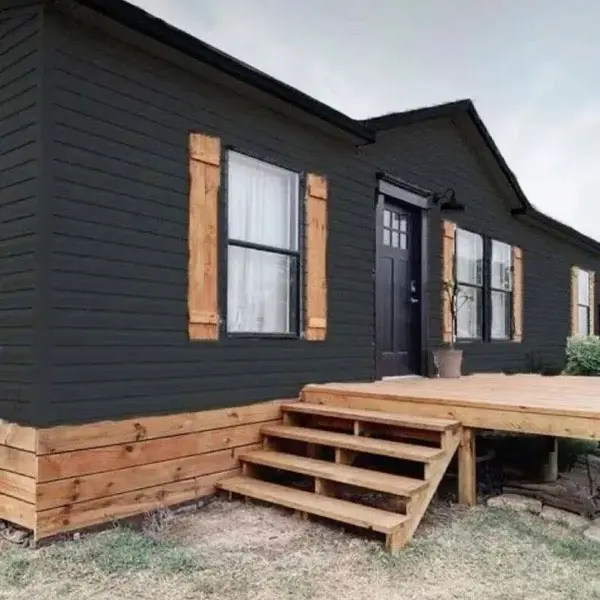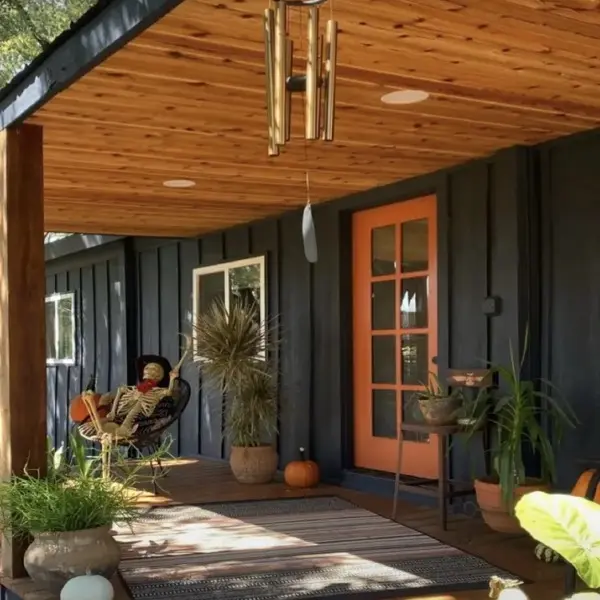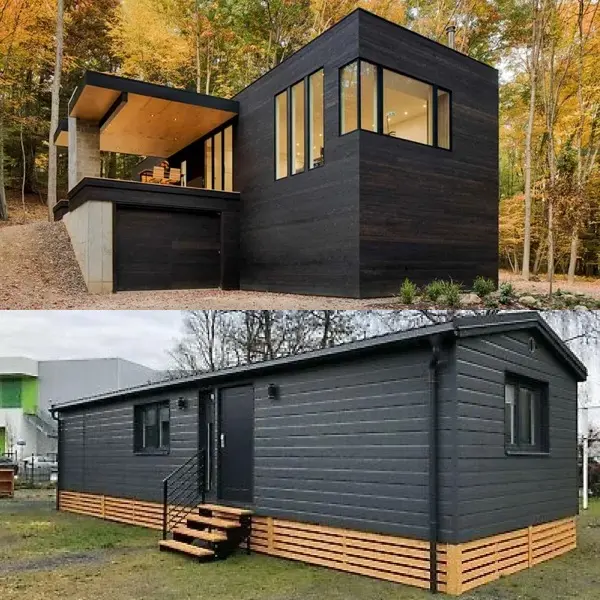December 12, 2024 • Written by Crystal Adkins • Homeowner Stories, Painting, Siding and Skirting
I Painted My Mobile Home Siding Black (Here’s What I Learned)
In my opinion, painting your mobile home’s exterior is a great place to start when you buy an older mobile home. It’s certainly the most affordable DIY project with the biggest impact and tells all the neighbors that you’re actively trying to improve the home and the neighborhood.
The exterior color of a mobile home is more than just an aesthetic choice; it absolutely affects temperature regulation and a home’s energy efficiency.
LRV (Light Reflective Value)
There is a universal measurement for color called Light Reflective Value. LRV, or light reflective value, measures how much light a color can reflect on a scale from 0 to 100. Lower LRV (0-40) indicates darker colors that absorb more light. Lighter colors have higher LRVs (60-100) and reflect more light.
Colors with low LRV, like many grays and blacks, can be tricky as they absorb surrounding colors and light. Black can absorb up to 90% of radiant energy, also called the sun’s light rays which we know as heat. Since black absorbs and doesn’t reflect, that heat is stuck new form of energy. This can lead to increased interior temperatures, especially in warmer climates and the house seemed a bit warmer in the evenings than it did before I painted it black. If I had to bet money on it, I’d say the black has absolutely increased my cooling costs. I can only hope it helped me save a bit on my heating in the winter.
Black Siding and Location Factors
The location, position, and shade should be considered if you want to paint your mobile home siding black, especially if you live in the south. Black paint may not reflect solar radiation, but it does reflect a cultural shift toward more expressive color palette for home design.
Market Trend
There is a growing trend towards using darker colors for exteriors. Black siding can lend a modern and sleek look to a mobile home, making it stand out. It pairs well with contrasting colors and vibrant landscapes. There is a growing trend towards using darker colors for exteriors, aligning with contemporary architectural designs. Black can evoke feelings of sophistication and elegance but may also appear foreboding if not balanced with lighter trim and landscaping.
Considerations in Heating and Cooling
Black paint can cause thermal expansion and contraction issues on metal siding and skirting. That’s because black absorbs more sunlight and heat than lighter colors. This increased heat absorption can significantly affect the material it’s applied to, especially metal.
Black siding can significantly increase cooling needs, leading to higher energy consumption and costs. Proper insulation and air conditioning are crucial for homes in the south. In cooler regions, black siding can help reduce heating costs by absorbing more sunlight (in theory).
Guidelines for Painting Metal and Vinyl Siding
New formulations for pain withstand the elements better and that increases its longevity and durability. I started painting the metal siding black with my $40 paint sprayer and $25can of Gliddeon Black from Walmart the next day.
Cleaning: Both metal and vinyl siding need to be thoroughly cleaned to ensure paint adhesion. Power washing is recommended.
Priming: Applying a primer suitable for the specific siding material is crucial to enhance paint durability.
Painting Techniques for Metal & Vinyl Siding
Metal Siding: Use acrylic or latex paint formulated for metal surfaces. Multiple thin coats are better than a single thick coat to avoid drips and ensure even coverage.
Vinyl Siding: Select paint that accommodates the expansion and contraction of vinyl. Lighter shades are usually recommended, but special formulations can allow for darker colors like black without warping.
Preparation is the Secret to Painting
- Surface Cleaning: Thoroughly clean the siding to remove dirt, mildew, and old paint flakes. Use a mixture of water and mild detergent or a commercial siding cleaner.
- Repair Damages: Fill any cracks or holes with appropriate sealants, allowing them to dry and cure as per instructions.
- Priming: For bare metal or vinyl, apply a high-quality primer to ensure better adhesion of the paint and longevity of the finish.
Choosing the Paint
- Choosing the Right Paint: Use acrylic latex paint for vinyl siding and specially formulated paints for metal that can withstand higher temperatures and resist peeling.
- Application Technique: Apply paint using a roller or paint sprayer for even coverage. Multiple thin coats are preferable to a single thick layer to prevent dripping and ensure an even finish.
- Drying and Curing: Allow each coat to dry as per manufacturer’s instructions before applying the next one. Curing times can vary, and adequate drying conditions must be maintained to avoid issues.
Thermal Expansion and Contraction: Effects on Metal Siding and Skirting
Black paint, especially on metal and vinyl, can cause thermal expansion and contraction issues, potentially reducing the lifespan of the siding material. This phenomenon, known as thermal shock, can lead to cracks and peeling over time.
Painting a dark color over a light vinyl isn’t advised, especially in the South because it can cause stress and warp the vinyl.
Heat Absorption and Expansion
Black surfaces heat up more because black absorbs all wavelengths of light and converts them into heat. This leads to higher surface temperatures. As the metal heats up, it expands. Metals have a property called the coefficient of thermal expansion, which quantifies how much a material expands per degree of temperature increase. When the temperature drops the metal cools down and contracts. This continuous cycle of expansion and contraction puts stress on the paint and the metal itself, potentially causing the paint to crack, chip, or peel.
Over time, the metal can undergo material fatigue due to the repeated stress. This can lead to warping or even structural damage in severe cases. Vinyl siding is especially prone to it which is why the experts advise against painting a light vinyl a dark color. Paint may lose adhesion to the metal surface because the continuous movement can weaken the bond between the paint and the metal. You can help mitigate the thermal expansion and contraction issues AND prolong the life of your mobile home’s siding by following the tips below.
Practical Advice
- Opt for paints that are designed to reflect more sunlight and minimize heat absorption.
- Regularly inspect and maintain the painted surfaces to address small issues before they become more severe.
- Ensure that the area behind the skirting and siding is well-ventilated to help dissipate heat.
Conclusion: Should You Paint a Mobile Home Black?
My answer is yes if you live above the Mason Dixon Line and Maybe if you’re below it. They paint houses black in Greenland and Iceland for a reason. The black holds heat in the home during the cold winters.
Fortunately, we have better ways of heating and cooling our homes but relying 100% on modern conviennces isn’t smart. Older mobile homes located in the South could use a little extra insulation to offset the heat created by black siding.
Here’s a handy chart I made for you to help decide whether you should paint your mobile home siding black:
Reflective Paint Technology and Enhanced Insulation
In-depth review of existing studies on color theory, heat absorption, and energy efficiency of reflective paint technology proves promising. A mobile home community in Arizona tested a new reflective black paint designed to minimize heat absorption. We know the idea is sound because it’s been used to seal flat mobile home roofs for decades. You may know it as Kool Seal. Results indicated a significant reduction in internal temperatures, demonstrating the efficacy of such technologies in mitigating traditional drawbacks of black siding.1
In Florida, a pilot project incorporating advanced insulation techniques in homes with black siding showed promising reductions in energy costs. Homes equipped with these insulation techniques maintained a stable indoor temperature despite external heat influences.2
I think that when it comes to mobile home siding, don’t be afraid to break the mold. We’re already breaking a mold by living in a mobile home so what’s one more? As always, thank you for reading Mobile Home Living. Have you painted your mobile or manufactured home a darker color? We’d love to add it to our gallery! Contact me in the comments below.
Related
Mobile home bathroom remodel
Repair Plumbing Ventilation Issues in Mobile Homes
Living Space Double Wide Mobile Home Newly Remodeled At Paradise Cove Rd, Malibu, C A
Guide to Removing Walls in a Mobile Home
Ultimate Guide to Mobile Home Additions
How to Replace a Subfloor in a Mobile Home: Step-by-Step Guide
Mobile Home Siding Guide
Entrance Into Living Room
Flooring Options for Mobile Homes





